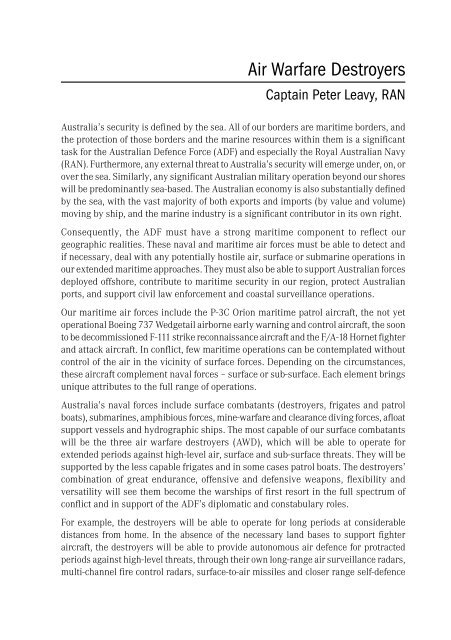Australian Maritime Issues 2007 - Royal Australian Navy
Australian Maritime Issues 2007 - Royal Australian Navy
Australian Maritime Issues 2007 - Royal Australian Navy
Create successful ePaper yourself
Turn your PDF publications into a flip-book with our unique Google optimized e-Paper software.
Air Warfare Destroyers<br />
Captain Peter Leavy, RAN<br />
Australia’s security is defined by the sea. All of our borders are maritime borders, and<br />
the protection of those borders and the marine resources within them is a significant<br />
task for the <strong>Australian</strong> Defence Force (ADF) and especially the <strong>Royal</strong> <strong>Australian</strong> <strong>Navy</strong><br />
(RAN). Furthermore, any external threat to Australia’s security will emerge under, on, or<br />
over the sea. Similarly, any significant <strong>Australian</strong> military operation beyond our shores<br />
will be predominantly sea-based. The <strong>Australian</strong> economy is also substantially defined<br />
by the sea, with the vast majority of both exports and imports (by value and volume)<br />
moving by ship, and the marine industry is a significant contributor in its own right.<br />
Consequently, the ADF must have a strong maritime component to reflect our<br />
geographic realities. These naval and maritime air forces must be able to detect and<br />
if necessary, deal with any potentially hostile air, surface or submarine operations in<br />
our extended maritime approaches. They must also be able to support <strong>Australian</strong> forces<br />
deployed offshore, contribute to maritime security in our region, protect <strong>Australian</strong><br />
ports, and support civil law enforcement and coastal surveillance operations.<br />
Our maritime air forces include the P-3C Orion maritime patrol aircraft, the not yet<br />
operational Boeing 737 Wedgetail airborne early warning and control aircraft, the soon<br />
to be decommissioned F-111 strike reconnaissance aircraft and the F/A-18 Hornet fighter<br />
and attack aircraft. In conflict, few maritime operations can be contemplated without<br />
control of the air in the vicinity of surface forces. Depending on the circumstances,<br />
these aircraft complement naval forces – surface or sub-surface. Each element brings<br />
unique attributes to the full range of operations.<br />
Australia’s naval forces include surface combatants (destroyers, frigates and patrol<br />
boats), submarines, amphibious forces, mine-warfare and clearance diving forces, afloat<br />
support vessels and hydrographic ships. The most capable of our surface combatants<br />
will be the three air warfare destroyers (AWD), which will be able to operate for<br />
extended periods against high-level air, surface and sub-surface threats. They will be<br />
supported by the less capable frigates and in some cases patrol boats. The destroyers’<br />
combination of great endurance, offensive and defensive weapons, flexibility and<br />
versatility will see them become the warships of first resort in the full spectrum of<br />
conflict and in support of the ADF’s diplomatic and constabulary roles.<br />
For example, the destroyers will be able to operate for long periods at considerable<br />
distances from home. In the absence of the necessary land bases to support fighter<br />
aircraft, the destroyers will be able to provide autonomous air defence for protracted<br />
periods against high-level threats, through their own long-range air surveillance radars,<br />
multi-channel fire control radars, surface-to-air missiles and closer range self-defence
















